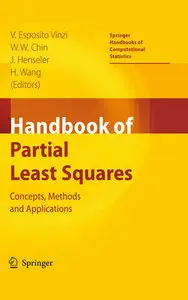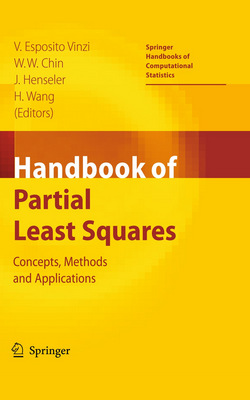"Handbook of Partial Least Squares: Concepts, Methods and Applications" ed. by Vincenzo Esposito Vinzi, Wynne W. Chin, Jörg Henseler, Huiwen Wang
Sрringеr Handbooks of Computational Statistics
Sрringеr | 2010 | ISBN: 3540328254 9783540328254 9783540328278 | 813 pages | PDF | 6 MB
Sрringеr Handbooks of Computational Statistics
Sрringеr | 2010 | ISBN: 3540328254 9783540328254 9783540328278 | 813 pages | PDF | 6 MB
This Handbook on Partial Least Squares (PLS) represents a comprehensive presentation of the current, original and most advanced research in the domain of PLS methods with specific reference to their use in Marketing-related areas and with a discussion of the forthcoming and most challenging directions of research and perspectives. The Handbook covers the broad area of PLS Methods from Regression to Structural Equation Modeling, from methods to applications, from software to interpretation of results.
The handbook serves both as an introduction for those without prior knowledge of PLS and as a comprehensive reference for researchers and practitioners interested in the most recent advances in PLS methodology.
Contents
List of Contributors
Editorial: Perspectives on Partial Least Squares
Part I Methods
PLS Path Modeling: Concepts, Model Estimation and Assessment
1 Latent Variables and Indices: Herman Wold's Basic Design and Partial Least Squares
2 PLS Path Modeling: From Foundations to Recent Developments and Open Issues for Model Assessment and Improvement
3 Bootstrap Cross-Validation Indices for PLS Path Model Assessment
PLS Path Modeling: Extensions
4 A Bridge Between PLS Path Modeling and Multi-Block Data Analysis
5 Use of ULS-SEM and PLS-SEM to Measure a Group Effect in a Regression Model Relating Two Blocks of Binary Variables
6 A New Multiblock PLS Based Method to Estimate Causal Models: Application to the Post-Consumption Behavior in Tourism
7 An Introduction to a Permutation Based Procedure for Multi-Group PLS Analysis: Results of Tests of Differences on Simulated Data and a Cross Cultural Analysis of the Sourcing of Information System Services Between Germany and the USA
PLS Path Modeling with Classification Issues
8 Finite Mixture Partial Least Squares Analysis: Methodology and Numerical Examples
9 Prediction Oriented Classification in PLS Path Modeling
10 Conjoint Use of Variables Clustering and PLS Structural Equations Modeling
PLS Path Modeling for Customer Satisfaction Studies
11 Design of PLS-Based Satisfaction Studies
12 A Case Study of a Customer Satisfaction Problem: Bootstrap and Imputation Techniques
13 Comparison of Likelihood and PLS Estimators for Structural Equation Modeling: A Simulation with Customer Satisfaction Data
14 Modeling Customer Satisfaction: A Comparative Performance Evaluation of Covariance Structure Analysis Versus Partial Least Squares
PLS Regression
15 PLS in Data Minina and Data Integration
16 Three-Block Data Modeling by Endo- and Exo-LPLS Regression
17 Regression Modelling Analysis on Compositional Data
Part II Applications to Marketing and Related Areas
18 PLS and Success Factor Studies in Marketing
19 Applying Maximum Likelihood and PLS on Different Sample Sizes: Studies on SERVQUAL Model and Employee Behavior Model
20 A PLS Model to Study Brand Preference: An Application to the Mobile Phone Market
21 An Application of PLS in Multi-Group Analysis: The Need for Differentiated Corporate-Level Marketing in the Mobile Communications Industry
22 Modeling the Impact of Corporate Reputation on Customer Satisfaction and Loyalty Using Partial Least Squares
23 Reframing Customer Value in a Service-Based Paradigm: An Evaluation of a Formative Measure in a Multi-industry, Cross-cultural Context
24 Analyzing Factorial Data Using PLS: Application in an Online Complaining Context
25 Application of PLS in Marketing: Content Strategies on the Internet
26 Use of Partial Least Squares (PLS) in TQM Research: TQM Practices and Business Performance in SMEs
27 Using PLS to Investigate Interaction Effects Between Higher Order Branding Constructs
Part III Tutorials
28 How to Write Up and Report PLS Analyses
29 Evaluation of Structural Equation Models Using the Partial Least Squares (PLS) Approach
30 Testing Moderating Effects in PLS Path Models: An Illustration of Available Procedures
31 A Comparison of Current PLS Path Modeling Software: Features, Ease-of-Use, and Performance
32 Introduction to SIMCA-P and Its Application
33 Interpretation of the Preferences of Automotive Customers Applied to Air Conditioning Supports by Combining GPA and PLS Regression
with TOC BookMarkLinks



